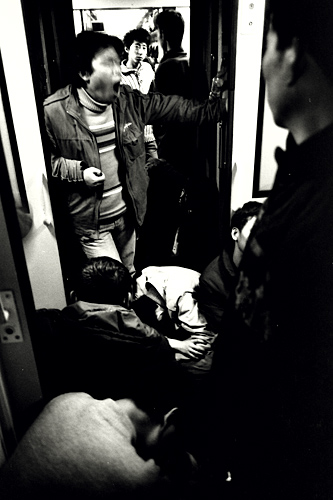Last months, we did the installation project in the class of Performative, Installation and Photography. Photographs are usually matted, framed and presented in the gallery. However, the purpose of installation is to activate the space and make the presentation itself an art piece. Then we looked for several different locations in the Fine Arts Building, Indiana University Bloomington.
My Installation
My piece is called “Reveal the Mysterious”. Initially, I got this idea when I walked in the fine arts building, especially in the fourth floor, in which the doors of the faculty offices are always closed. There are even a small label on each door which reject the janitors to enter and clean. Then the whole fourth floor seems to be only a hallway to me, and all the remaining is the unknown mysterious space.
Through my installation, I would like to photograph the inner parts of the rooms, and mirror them out by life size prints.When I reach the practical part, I changed my mind a little because there’re few people walking in the fourth floor, and I need a more popular location. Then I get the permission for the hallway in the ground floor, outside the restrooms and a janitor’s closet. I took photos of the men’s restroom and the closet, stitched all the photos together to make one large pieces in Photoshop, and make lied size large-scale prints and mount them on the wall. OK, now it looked like the restrooms and closet were brought out to the hallway.
When I was installing the works in a late night, a janitor came to see the photo of urinals and said, “What will happen if someone really pee on it?” Of course, this is a joke, but it really reminds me that the project is not only about the space itself, but also an interactive project with the viewers! Think about what people do in the restrooms! If I let them do anything just as they’re actually in these rooms, we may expect something interesting happen. Then I wrote this in the statements.
Then, what happened was, the graffiti filled up the installation in one weeks, just as in the real restrooms. Some of them are really interesting. For example, someone wrote “R.Mutt” in one of the urinals, which directly reflect to Marchel Duchamp’s Fountain (1917), the very beginning of the conceptual art. Someones replies each other and makes the installation as a information board, which reminds the way we share the information before the Internet. Also many funny and humor pieces came out. Of course, there’re some dirty stuff, just as what we always see in the restrooms.
I also realized people drew much more on the wall of the restroom than the closet. The phenomenon might reflect how the people think about these rooms.
The feedback came from both the students, faculty and the janitors, who are unusually talking to the students. From what I know, they all love the installation. One of them said to me, “Oh, there’re my materials. I’m supposed to get from the closet. ” And they talked to me a lot about the techniques. They also thought the installation had reduced the graffiti drawing in the real bathrooms. Some of them said I should keep the installation on to protect the bathrooms. I did examine the men’s bathroom, and there’re no new drawings during the installation period. Then I think the department would like my pieces to be renewed twice a month to keep the real ones clean!
The “Offensive” Issue
Now comes the problem! The installation was on from Oct 19 to 21, by the permission from the office. Because all the installations in the class are so successful, we decided to make an extension and invite the ones all over the university to come. Our professor, Mariana Tres, wrote an email to the office. However, it was rejected immediately after the application. The reply particularly mentioned two pieces they didn’t like. One is my piece, and they said, “the graffiti on the hallway installation is already offensive to some.”
Of course, all of the classmates got hurt and angry because it’s the fine arts building, and we didn’t get any support from the department when we did the installations and they did decorate and bring much more artistic feeling to the whole building. We didn’t get any tolerant for our works. This week, Mariana had a meeting to the department head Tim Mather and we all signed a letter to the department. (Actually, what happened was, Tim, who is a ceramic artist and the department head for years, was out of town during that week, and his assistant, who was not from an art major, made the decision.)
Actually another piece was forced to remove even before. It was a beautiful piece called “Falling away”, which recreate the feeling of the short fall in the stairway. However, there happened to be a fire drill and the firemen insisted the piece blocked the way and should be removed immediately. Otherwise, they will fine the fine arts building. Then we dealer with the fire marshals, the officials in the town and even the Indiana Department of Homeland Security!
Anyway, we were really said to remove our installations on Oct 26. However, all the happenings brought a lot of social meanings and inspired us a lot about the installation, the society, the authorities and the public arts. I’m very glad that my piece became one of controversies.
From the office, “Offensive” becomes a label for my installation. Personally, I don’t think the installation itself is offensive at all, and that’s totally not my purpose, while I do agree the some of the graffiti on it is really offensive. However, it’s not related to the artwork itself if we define the prints and installation as the artwork. People really have these behaves in the real bathrooms and somewhere else. My installation was just a platform to bring the “secret” out and to get the public concerns.
Now I think my installation as a social practice. The viewers themselves and their activities become part of the artwork, and the artwork itself grows with the touching of the viewers. What was shown is happening in the public area, though we don’t see them frequently, but we do see them everyday. I personally don’t like the offensive graffiti at all, but they do exist in every bathrooms and their appearance on the installation really reminds us this fact and makes us concern more about the phenomenon. Then if we think the installation and the growing process altogether as an artwork, we could label it an offensive piece. If someone saw its offensiveness, I think it just shows the artwork works. Then what we need to do is not to stop this installation but to deal with the real thing happens, either try to understand the graffiti makers, or to educate them stop doing this.
Finale: the lifecycle of the installation
Though I don’t think it’s reasonable to have the mandatory removal, and I don’t understand its necessarily, I feel acceptable to deinstall it because it reaches its lifecycle. The drawing and graffiti was filled up everywhere and we’ve already got enough feedback, especially the one from the office. They’re part of the life of the installation. If it continues to be there, I need to renew the prints to give the viewers more space. Otherwise, the piece will lose its function and become a dead piece.
Last months, we did the installation project in the class of Performative, Installation and Photography. Photographs are usually matted, framed and presented in the gallery. However, the purpose of installation is to activate the space and make the presentation itself an art piece. Then we looked for several different locations in the Fine Arts Building, Indiana University Bloomington.
My Installation
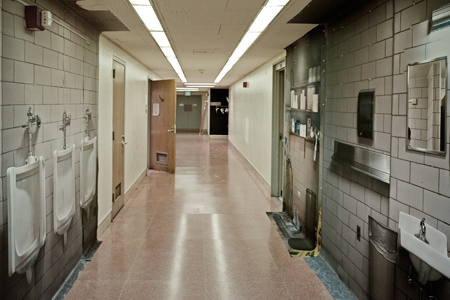
Reveal the Mysterious, My Installation Project
Installed in the first floor hallway, Fine Arts Building, Indiana University Bloomington, Oct.19 – Oct.25
My piece is called “Reveal the Mysterious”. Initially, I got this idea when I walked in the fine arts building, especially in the fourth floor, in which the doors of the faculty offices are always closed. There are even a small label on each door which reject the janitors to enter and clean. Then the whole fourth floor seems to be only a hallway to me, and all the remaining is the unknown mysterious space.
Through my installation, I would like to photograph the inner parts of the rooms, and mirror them out by life size prints.When I reach the practical part, I changed my mind a little because there’re few people walking in the fourth floor, and I need a more popular location. Then I get the permission for the hallway in the ground floor, outside the restrooms and a janitor’s closet. I took photos of the men’s restroom and the closet, stitched all the photos together to make one large pieces in Photoshop, and make lied size large-scale prints and mount them on the wall. OK, now it looked like the restrooms and closet were brought out to the hallway.
When I was installing the works in a late night, a janitor came to see the photo of urinals and said, “What will happen if someone really pee on it?” Of course, this is a joke, but it really reminds me that the project is not only about the space itself, but also an interactive project with the viewers! Think about what people do in the restrooms! If I let them do anything just as they’re actually in these rooms, we may expect something interesting happen. Then I wrote this in the statements.
Then, what happened was, the graffiti filled up the installation in one weeks, just as in the real restrooms. Some of them are really interesting. For example, someone wrote “R.Mutt” in one of the urinals, which directly reflect to Marchel Duchamp’s Fountain (1917), the very beginning of the conceptual art. Someones replies each other and makes the installation as a information board, which reminds the way we share the information before the Internet. Also many funny and humor pieces came out. Of course, there’re some dirty stuff, just as what we always see in the restrooms.
I also realized people drew much more on the wall of the restroom than the closet. The phenomenon might reflect how the people think about these rooms.
The feedback came from both the students, faculty and the janitors, who are unusually talking to the students. From what I know, they all love the installation. One of them said to me, “Oh, there’re my materials. I’m supposed to get from the closet. ” And they talked to me a lot about the techniques. They also thought the installation had reduced the graffiti drawing in the real bathrooms. Some of them said I should keep the installation on to protect the bathrooms. I did examine the men’s bathroom, and there’re no new drawings during the installation period. Then I think the department would like my pieces to be renewed twice a month to keep the real ones clean!
The “Offensive” Issue
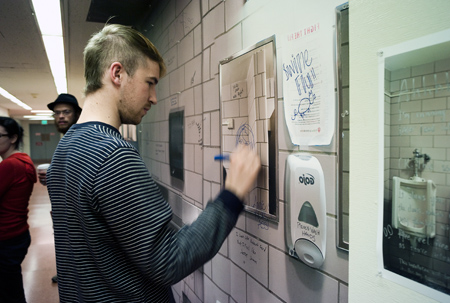
The viewer interacted with the installation
Now comes the problem! The installation was on from Oct 19 to 21, by the permission from the office. Because all the installations in the class are so successful, we decided to make an extension and invite the ones all over the university to come. Our professor, Mariana Tres, wrote an email to the office. However, it was rejected immediately after the application. The reply particularly mentioned two pieces they didn’t like. One is my piece, and they said, “the graffiti on the hallway installation is already offensive to some.”
Of course, all of the classmates got hurt and angry because it’s the fine arts building, and we didn’t get any support from the department when we did the installations and they did decorate and bring much more artistic feeling to the whole building. We didn’t get any tolerant for our works. This week, Mariana had a meeting to the department head Tim Mather and we all signed a letter to the department. (Actually, what happened was, Tim, who is a ceramic artist and the department head for years, was out of town during that week, and his assistant, who was not from an art major, made the decision.)
Actually another piece was forced to remove even before. It was a beautiful piece called “Falling away”, which recreate the feeling of the short fall in the stairway. However, there happened to be a fire drill and the firemen insisted the piece blocked the way and should be removed immediately. Otherwise, they will fine the fine arts building. Then we dealer with the fire marshals, the officials in the town and even the Indiana Department of Homeland Security!
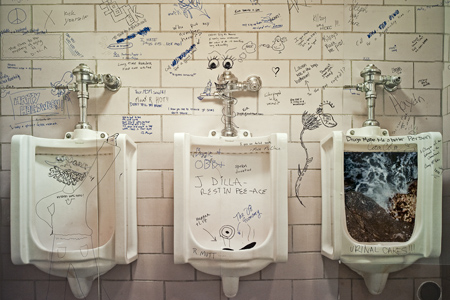
The final looking of the installation
Pay attention to the “R.MUTT” on the center urinal
Anyway, we were really said to remove our installations on Oct 26. However, all the happenings brought a lot of social meanings and inspired us a lot about the installation, the society, the authorities and the public arts. I’m very glad that my piece became one of controversies.
From the office, “Offensive” becomes a label for my installation. Personally, I don’t think the installation itself is offensive at all, and that’s totally not my purpose, while I do agree the some of the graffiti on it is really offensive. However, it’s not related to the artwork itself if we define the prints and installation as the artwork. People really have these behaves in the real bathrooms and somewhere else. My installation was just a platform to bring the “secret” out and to get the public concerns.
Now I think my installation as a social practice. The viewers themselves and their activities become part of the artwork, and the artwork itself grows with the touching of the viewers. What was shown is happening in the public area, though we don’t see them frequently, but we do see them everyday. I personally don’t like the offensive graffiti at all, but they do exist in every bathrooms and their appearance on the installation really reminds us this fact and makes us concern more about the phenomenon. Then if we think the installation and the growing process altogether as an artwork, we could label it an offensive piece. If someone saw its offensiveness, I think it just shows the artwork works. Then what we need to do is not to stop this installation but to deal with the real thing happens, either try to understand the graffiti makers, or to educate them stop doing this.
Finale: The Lifecycle of The Installation
Though I don’t think it’s reasonable to have the mandatory removal, and I don’t understand its necessarily, I feel acceptable to deinstall it because it reaches its lifecycle. The drawing and graffiti was filled up everywhere and we’ve already got enough feedback, especially the one from the office. They’re part of the life of the installation. If it continues to be there, I need to renew the prints to give the viewers more space. Otherwise, the piece will lose its function and become a dead piece.
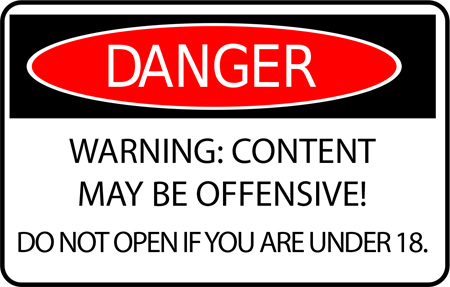
The DANGER sign I made to seal the rolls
Finally, I removed all the prints and wrap them back as the paper rolls. I printed the labels which say “DANGER! WARNING: CONTENT MAY BE OFFENSIVE! DO NOT OPEN IF YOU ARE UNDER 18.”, and used them to seal all the rolls, and put these rolls to make a small installation in my MFA critique, which was my repines to the department.
P.S.: An Official Response to the Installations
A few weeks after our installation projects, the department come out a new on-campus installation form, which is kind of an official response to the projects because the items seem to be match exactly what happened in the class. So I list the form note here.
On-Campus Installation Form
Note:
1. Installations can never be set up on stairs or in stairwells.
2. Proof of permission from IU personnel if installing in other building or on campus grounds MUST be attached (letter or email).
3. Use of flammable or toxic materials or materials situated in such a way that they could catch fire (i.e. fabric draped on lights, overloaded power plugs, etc.) or pose a safety hazard is prohibited.
4. Artwork with sound cannot be set up in arid close to staff offices or classrooms.
5. This form must be submitted 5 WORKING DAYS prior to installation in the event artist’s construction cannot be accommodated or must be re-worked due to safety violations.
6. Student is responsible for thorough cleanup of their work. Any damage to campus grounds or building walls/floors/ceilings due to the attachment materials, excessive weight, liquid spills, etc. is the student’s financial responsibility if area is not left in state prior to installation. Please note with your instructor if area of install has pre-existing damage (what type and where) and document in detail on the back of form.






